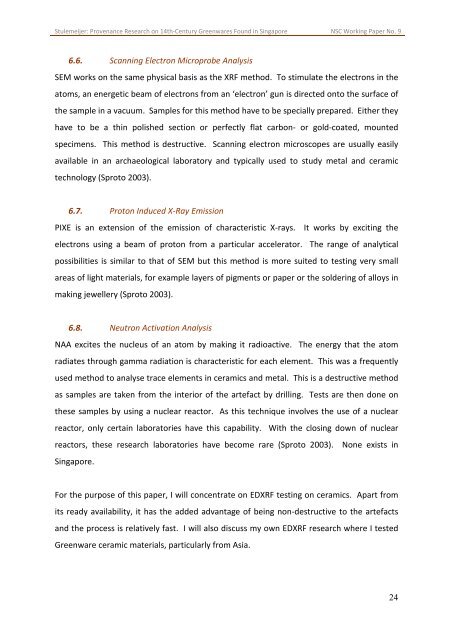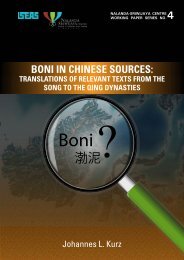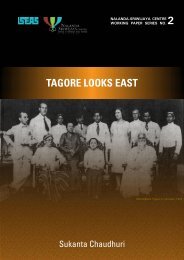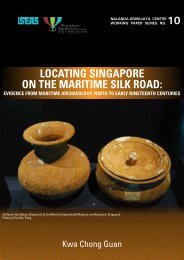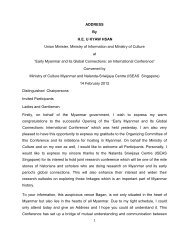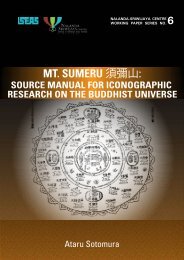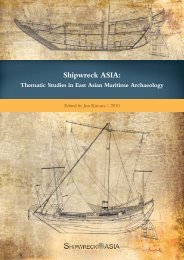provenance research on 14th-century greenwares found in singapore
provenance research on 14th-century greenwares found in singapore
provenance research on 14th-century greenwares found in singapore
Create successful ePaper yourself
Turn your PDF publications into a flip-book with our unique Google optimized e-Paper software.
Stulemeijer: Provenance Research <strong>on</strong> <strong>14th</strong>-Century Greenwares Found <strong>in</strong> S<strong>in</strong>gapore NSC Work<strong>in</strong>g Paper No. 9<br />
6.6. Scann<strong>in</strong>g Electr<strong>on</strong> Microprobe Analysis<br />
SEM works <strong>on</strong> the same physical basis as the XRF method. To stimulate the electr<strong>on</strong>s <strong>in</strong> the<br />
atoms, an energetic beam of electr<strong>on</strong>s from an ‘electr<strong>on</strong>’ gun is directed <strong>on</strong>to the surface of<br />
the sample <strong>in</strong> a vacuum. Samples for this method have to be specially prepared. Either they<br />
have to be a th<strong>in</strong> polished secti<strong>on</strong> or perfectly flat carb<strong>on</strong>- or gold-coated, mounted<br />
specimens. This method is destructive. Scann<strong>in</strong>g electr<strong>on</strong> microscopes are usually easily<br />
available <strong>in</strong> an archaeological laboratory and typically used to study metal and ceramic<br />
technology (Sproto 2003).<br />
6.7. Prot<strong>on</strong> Induced X-Ray Emissi<strong>on</strong><br />
PIXE is an extensi<strong>on</strong> of the emissi<strong>on</strong> of characteristic X-rays. It works by excit<strong>in</strong>g the<br />
electr<strong>on</strong>s us<strong>in</strong>g a beam of prot<strong>on</strong> from a particular accelerator. The range of analytical<br />
possibilities is similar to that of SEM but this method is more suited to test<strong>in</strong>g very small<br />
areas of light materials, for example layers of pigments or paper or the solder<strong>in</strong>g of alloys <strong>in</strong><br />
mak<strong>in</strong>g jewellery (Sproto 2003).<br />
6.8. Neutr<strong>on</strong> Activati<strong>on</strong> Analysis<br />
NAA excites the nucleus of an atom by mak<strong>in</strong>g it radioactive. The energy that the atom<br />
radiates through gamma radiati<strong>on</strong> is characteristic for each element. This was a frequently<br />
used method to analyse trace elements <strong>in</strong> ceramics and metal. This is a destructive method<br />
as samples are taken from the <strong>in</strong>terior of the artefact by drill<strong>in</strong>g. Tests are then d<strong>on</strong>e <strong>on</strong><br />
these samples by us<strong>in</strong>g a nuclear reactor. As this technique <strong>in</strong>volves the use of a nuclear<br />
reactor, <strong>on</strong>ly certa<strong>in</strong> laboratories have this capability. With the clos<strong>in</strong>g down of nuclear<br />
reactors, these <str<strong>on</strong>g>research</str<strong>on</strong>g> laboratories have become rare (Sproto 2003). N<strong>on</strong>e exists <strong>in</strong><br />
S<strong>in</strong>gapore.<br />
For the purpose of this paper, I will c<strong>on</strong>centrate <strong>on</strong> EDXRF test<strong>in</strong>g <strong>on</strong> ceramics. Apart from<br />
its ready availability, it has the added advantage of be<strong>in</strong>g n<strong>on</strong>-destructive to the artefacts<br />
and the process is relatively fast. I will also discuss my own EDXRF <str<strong>on</strong>g>research</str<strong>on</strong>g> where I tested<br />
Greenware ceramic materials, particularly from Asia.<br />
24


